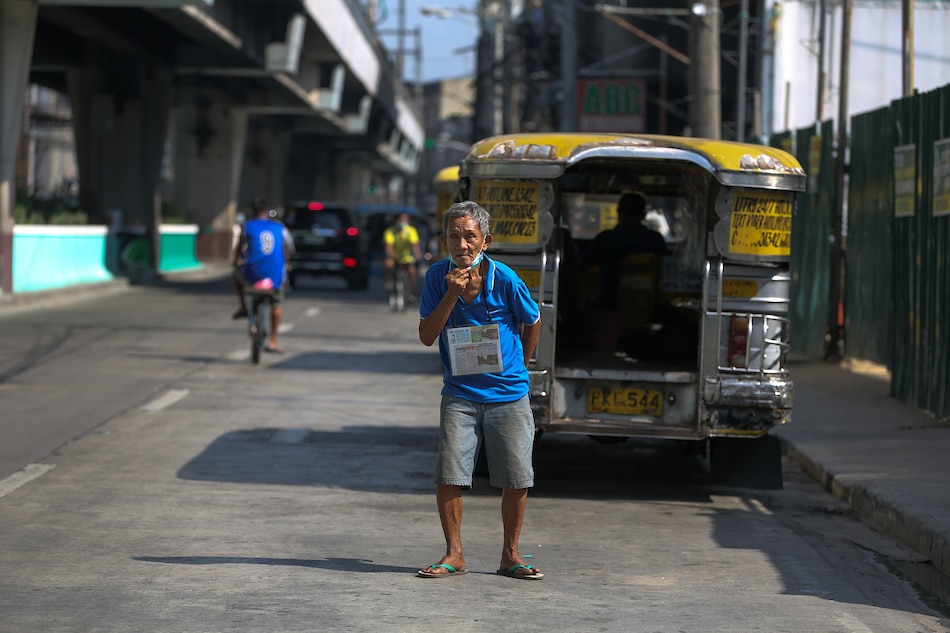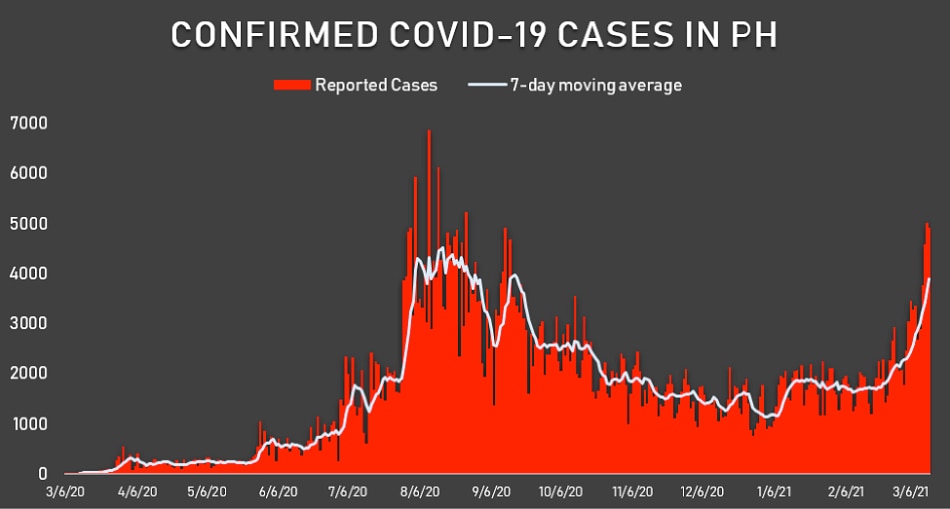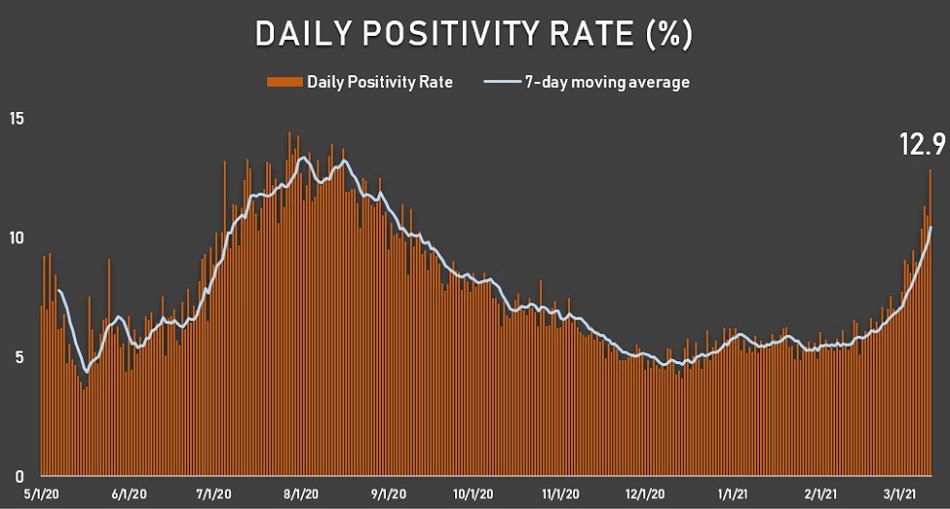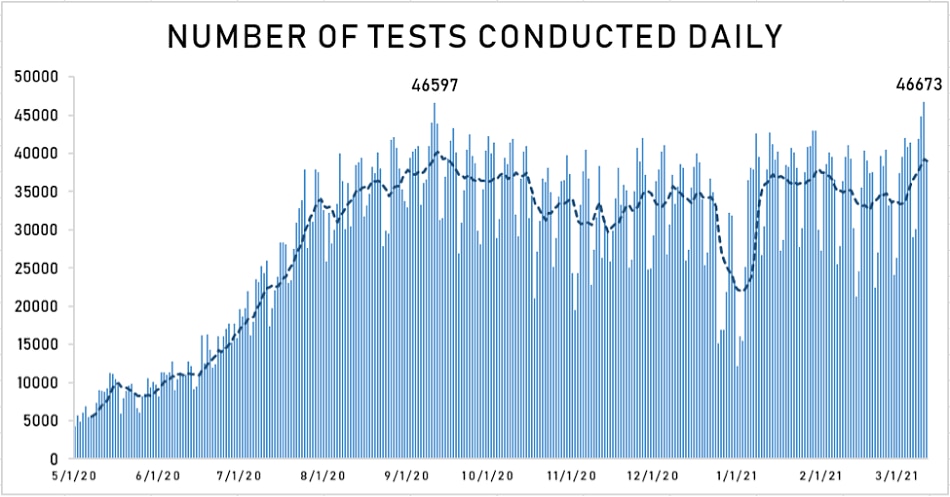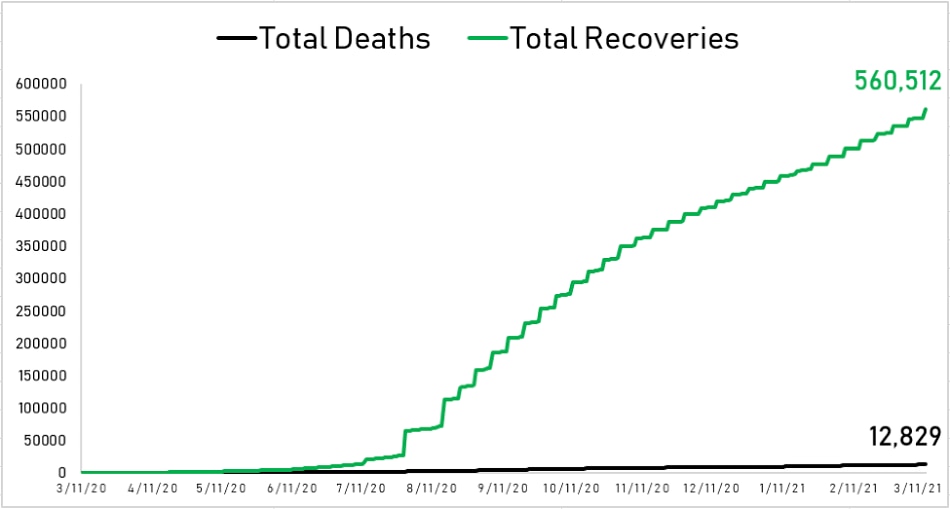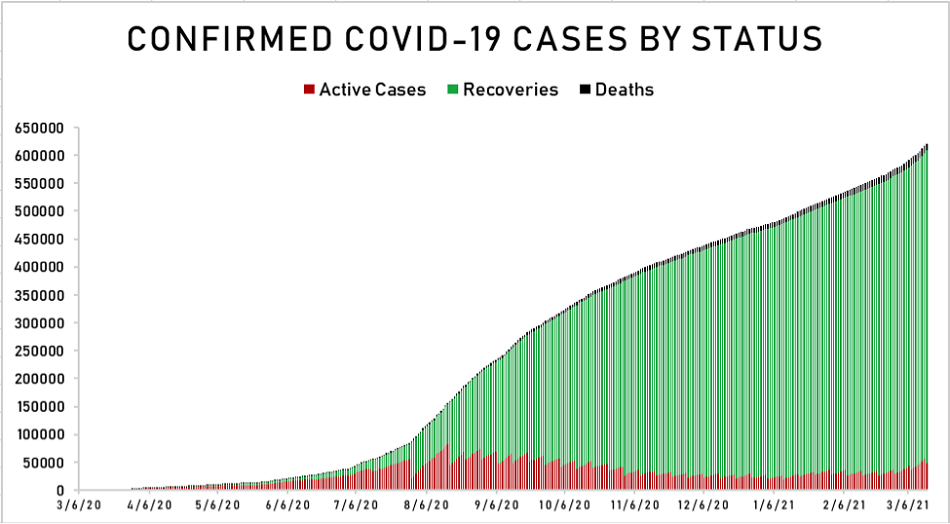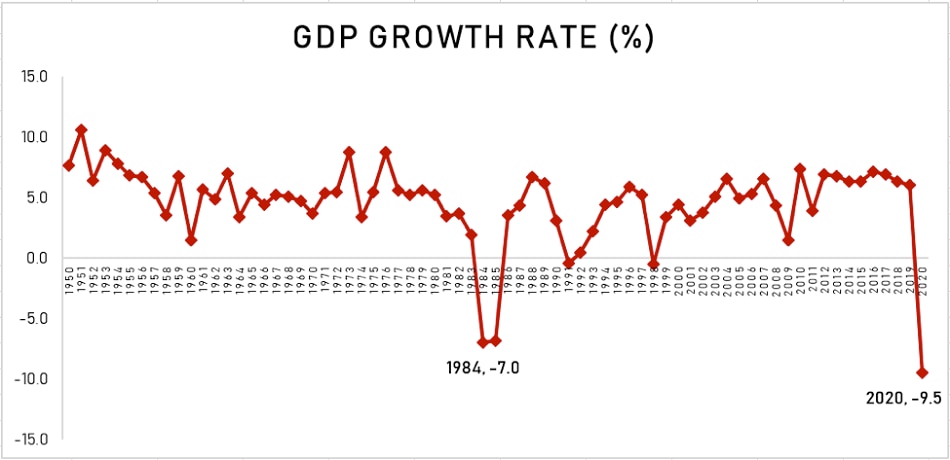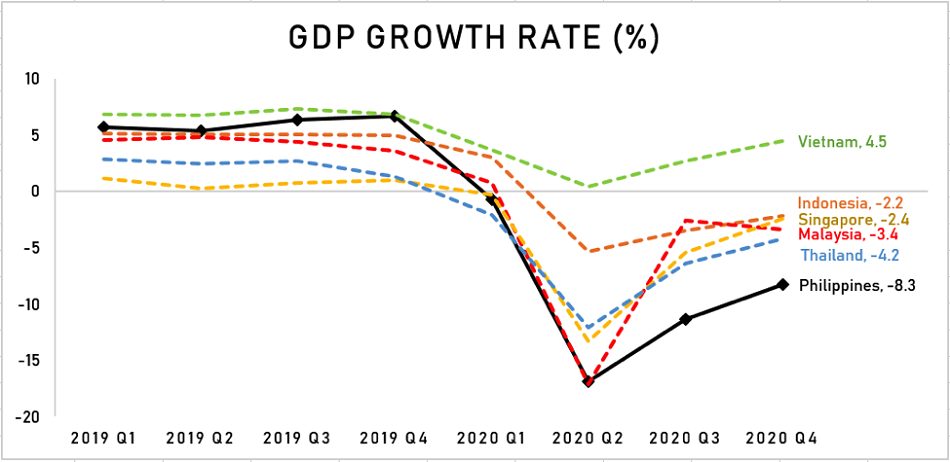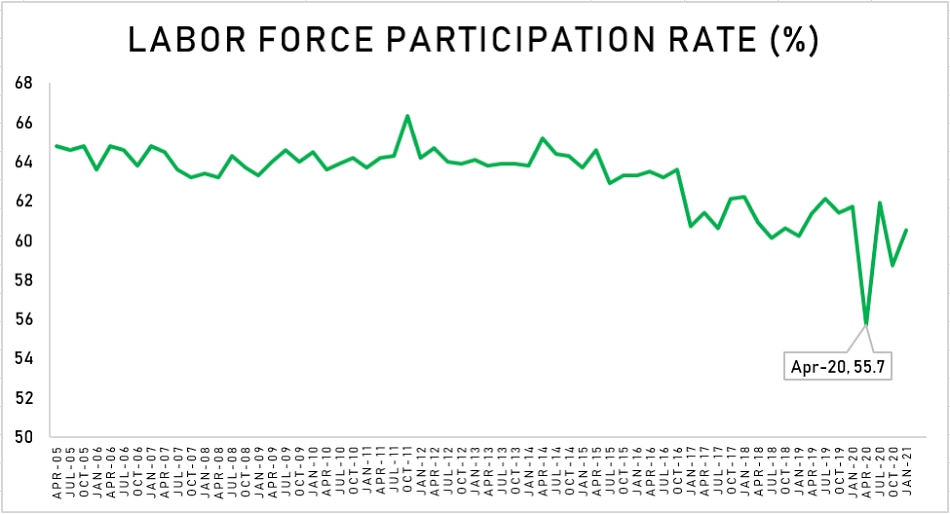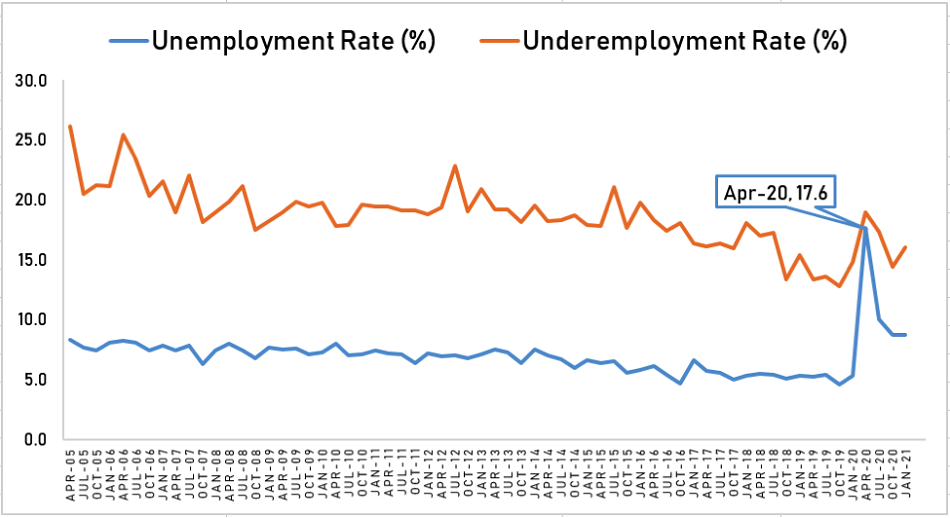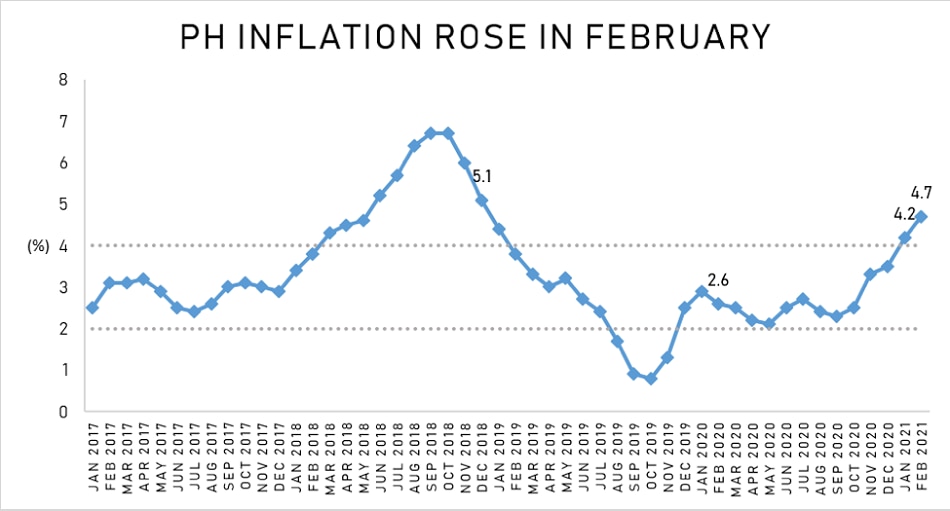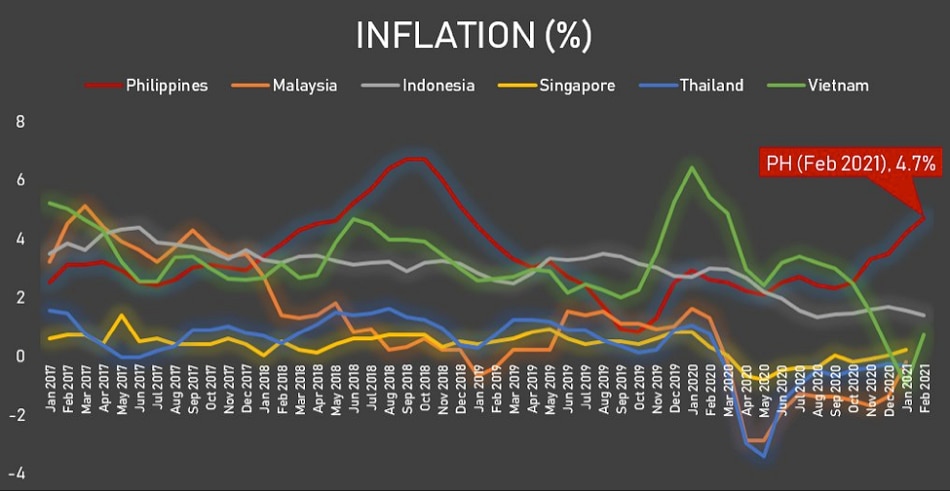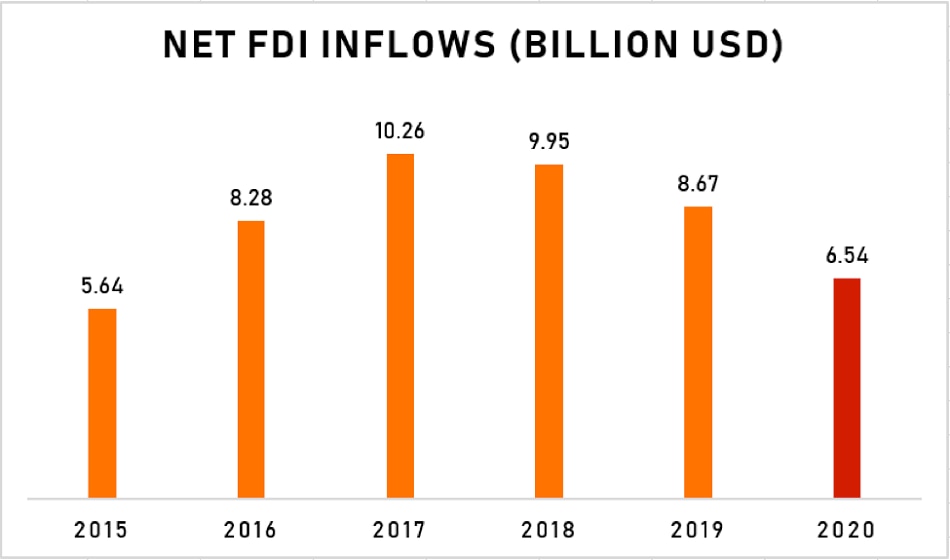Dissecting Data: The economy after a year into the COVID-19 pandemic | ABS-CBN
ADVERTISEMENT

Welcome, Kapamilya! We use cookies to improve your browsing experience. Continuing to use this site means you agree to our use of cookies. Tell me more!
Dissecting Data: The economy after a year into the COVID-19 pandemic
Dissecting Data: The economy after a year into the COVID-19 pandemic
Warren de Guzman and Edson Guido,
ABS-CBN News
Published Mar 15, 2021 10:28 PM PHT
|
Updated Nov 04, 2024 09:48 PM PHT
How the Philippines crippled its economy and squandered the world's longest lockdown
How the Philippines crippled its economy and squandered the world's longest lockdown
MANILA - On March 15, 2020, President Rodrigo Duterte placed the entire National Capital Region (NCR) under strict quarantine to arrest the spread of COVID-19 across the Philippines. In the days, weeks, and months that followed, he expanded the quarantine to the rest of the country, introduced four levels of quarantine protocols, and conducted weekly assessments of the coronavirus outbreak to determine what to do with the lockdowns moving forward.
MANILA - On March 15, 2020, President Rodrigo Duterte placed the entire National Capital Region (NCR) under strict quarantine to arrest the spread of COVID-19 across the Philippines. In the days, weeks, and months that followed, he expanded the quarantine to the rest of the country, introduced four levels of quarantine protocols, and conducted weekly assessments of the coronavirus outbreak to determine what to do with the lockdowns moving forward.
A year since that day, the Philippines now has the longest COVID-19 lockdown in the world and it is still ongoing. What was the impact of the lockdown? What were the consequences? Did it accomplish its purpose in slowing and stopping the outbreak?
A year since that day, the Philippines now has the longest COVID-19 lockdown in the world and it is still ongoing. What was the impact of the lockdown? What were the consequences? Did it accomplish its purpose in slowing and stopping the outbreak?
The ABS-CBN Data Analytics breaks the data down.
The ABS-CBN Data Analytics breaks the data down.
Enhanced Community Quarantine was imposed over Metro Manila on March 15, and later expanded to the entire Luzon the next day. The measures appeared to have arrested an uptrend in confirmed COVID-19 cases in early April, which corresponds with the 14-day incubation period of the virus. The number of confirmed cases reported daily were kept relatively under control, as shown by the line graph representing the 7-day moving average of reported cases.
Enhanced Community Quarantine was imposed over Metro Manila on March 15, and later expanded to the entire Luzon the next day. The measures appeared to have arrested an uptrend in confirmed COVID-19 cases in early April, which corresponds with the 14-day incubation period of the virus. The number of confirmed cases reported daily were kept relatively under control, as shown by the line graph representing the 7-day moving average of reported cases.
ADVERTISEMENT
This led to President Duterte easing lockdown conditions in NCR and other select areas starting under Modified Enhanced Community Quarantine in May, and then General Community Quarantine in June, to prioritize the revival of economic activity. Unfortunately, new cases would start to spike after the moves. Certain areas were once again placed under tighter community quarantine, including Cebu City and NCR as new cases hit record-highs in August and stayed elevated in September.
This led to President Duterte easing lockdown conditions in NCR and other select areas starting under Modified Enhanced Community Quarantine in May, and then General Community Quarantine in June, to prioritize the revival of economic activity. Unfortunately, new cases would start to spike after the moves. Certain areas were once again placed under tighter community quarantine, including Cebu City and NCR as new cases hit record-highs in August and stayed elevated in September.
However, daily reported cases started to ease in November and December. The first two months of 2021 were relatively quiet, raising hopes for plans to ease lockdown conditions to the lowest level of community quarantine by March.
However, daily reported cases started to ease in November and December. The first two months of 2021 were relatively quiet, raising hopes for plans to ease lockdown conditions to the lowest level of community quarantine by March.
But late February and early March have proven disastrous. New COVID-19 cases are surging and the virus has already exceeded some of the highs hit in 2020. Five thousand new COVID-19 cases were reported on March 13. This was the highest since August. A day after, 4,899 new cases were reported.
But late February and early March have proven disastrous. New COVID-19 cases are surging and the virus has already exceeded some of the highs hit in 2020. Five thousand new COVID-19 cases were reported on March 13. This was the highest since August. A day after, 4,899 new cases were reported.
Today, the Philippines on Monday recorded 5,404 new coronavirus infections, the fourth highest reported since the start of the outbreak, and the highest since Aug. 14 last year.
Today, the Philippines on Monday recorded 5,404 new coronavirus infections, the fourth highest reported since the start of the outbreak, and the highest since Aug. 14 last year.
What happened? President Duterte decided against easing quarantine levels by March, but the Inter-Agency Task Force or IATF, together with Local Government Units and business leaders, had steadily removed some of the movement restrictions to generate more economic activity. These restrictions included mobility limits on young and old citizens.
What happened? President Duterte decided against easing quarantine levels by March, but the Inter-Agency Task Force or IATF, together with Local Government Units and business leaders, had steadily removed some of the movement restrictions to generate more economic activity. These restrictions included mobility limits on young and old citizens.
ADVERTISEMENT
Others attributed the recent surge to the arrival of new COVID-19 variants. Some of these were imported from other parts of the world, but there is also one new variant that was first identified in the Philippines. Whatever the reason, there is no denying the number of new COVID-19 cases is increasing rapidly.
Others attributed the recent surge to the arrival of new COVID-19 variants. Some of these were imported from other parts of the world, but there is also one new variant that was first identified in the Philippines. Whatever the reason, there is no denying the number of new COVID-19 cases is increasing rapidly.
The daily positivity rate shown in the chart above measures the number of confirmed positive COVID-19 cases against the number of individuals tested. The World Health Organization has long held a daily positivity rate of 5 percent, sustained for two weeks, as the ideal condition for the lifting or easing of quarantine restrictions.
The daily positivity rate shown in the chart above measures the number of confirmed positive COVID-19 cases against the number of individuals tested. The World Health Organization has long held a daily positivity rate of 5 percent, sustained for two weeks, as the ideal condition for the lifting or easing of quarantine restrictions.
The Philippines averaged 5.04 percent in December last year. But last March 12, the positivity rate hit 12.9 percent, the highest since August 2020.
The Philippines averaged 5.04 percent in December last year. But last March 12, the positivity rate hit 12.9 percent, the highest since August 2020.
The surge in the daily positivity rate was accompanied by more aggressive testing. A total of 46,673 COVID-19 tests were conducted on March 11, more than the previous high of 46,597 in September.
The surge in the daily positivity rate was accompanied by more aggressive testing. A total of 46,673 COVID-19 tests were conducted on March 11, more than the previous high of 46,597 in September.
If the COVID-19 outbreak was under control, more aggressive testing would lead to a lower positivity rate. Instead, the wider testing activities have revealed more positive COVID-19 cases.
There was also a notable drop-off in COVID-19 testing done in late December and early January, indicating the government was not able to institute measures to maintain testing effort during the holidays. This means data presented for those days were much less accurate compared to other periods with high amounts of testing.
There was also a notable drop-off in COVID-19 testing done in late December and early January, indicating the government was not able to institute measures to maintain testing effort during the holidays. This means data presented for those days were much less accurate compared to other periods with high amounts of testing.
ADVERTISEMENT
The good news is the majority of confirmed COVID-19 cases in the Philippines resulted in recoveries. The bad news-- some of the Philippine government’s inefficient data collection and presentation practices have remained a year into the lockdown. One such practice is the government’s release of data on COVID-19 recoveries. It releases data showing thousands of recoveries on Sundays, resulting in a ladder-like chart for total recoveries.
The good news is the majority of confirmed COVID-19 cases in the Philippines resulted in recoveries. The bad news-- some of the Philippine government’s inefficient data collection and presentation practices have remained a year into the lockdown. One such practice is the government’s release of data on COVID-19 recoveries. It releases data showing thousands of recoveries on Sundays, resulting in a ladder-like chart for total recoveries.
Other bad data practices that remain in place include the late reporting and even retagging of COVID-19 deaths. A high percentage of COVID-19 deaths are, to this day, happening outside of proper hospital care. There are still laboratories that don’t report their data as well. Some fail to transmit timely data for valid reasons varying from weather disturbances to COVID-19 infections among lab personnel. Other labs fail to transmit data without reporting a reason.
Other bad data practices that remain in place include the late reporting and even retagging of COVID-19 deaths. A high percentage of COVID-19 deaths are, to this day, happening outside of proper hospital care. There are still laboratories that don’t report their data as well. Some fail to transmit timely data for valid reasons varying from weather disturbances to COVID-19 infections among lab personnel. Other labs fail to transmit data without reporting a reason.
The data collection and presentation issues have led to some distrust in the COVID-19 tracking data of the Department of Health (DOH), which relies on local government units and disease reporting units on the ground. However, the DOH data remain the only information available to measure the fight against COVID-19 in the Philippines. As imperfect it might be, it still shows more COVID-19 cases end up as recoveries than deaths.
The data collection and presentation issues have led to some distrust in the COVID-19 tracking data of the Department of Health (DOH), which relies on local government units and disease reporting units on the ground. However, the DOH data remain the only information available to measure the fight against COVID-19 in the Philippines. As imperfect it might be, it still shows more COVID-19 cases end up as recoveries than deaths.
There are a few key takeaways from the one year’s worth of COVID-19 data in the Philippines.
There are a few key takeaways from the one year’s worth of COVID-19 data in the Philippines.
First, the lockdowns worked to slow the spread of COVID-19 initially. However they eventually proved inefficient and ineffective, especially after certain mobility restrictions were lifted to allow for more economic activity. The recent surge has erased all of the gains achieved by the quarantines.
First, the lockdowns worked to slow the spread of COVID-19 initially. However they eventually proved inefficient and ineffective, especially after certain mobility restrictions were lifted to allow for more economic activity. The recent surge has erased all of the gains achieved by the quarantines.
ADVERTISEMENT
Second, the Philippines’ data collection practices have not evolved enough to eliminate inefficiencies encountered in the early fight against the virus.
Second, the Philippines’ data collection practices have not evolved enough to eliminate inefficiencies encountered in the early fight against the virus.
Third, COVID-19 is still in the Philippines, and it is poised to spread at an even faster rate compared to the worst months of 2020.
Third, COVID-19 is still in the Philippines, and it is poised to spread at an even faster rate compared to the worst months of 2020.
In the early days of the lockdown, the Duterte administration discussed the quarantine measures as a necessary sacrifice of economic activity to fight the COVID-19 pandemic. Toward the end of 2020, the government vowed it would never sacrifice the economy again to fight off COVID, and would instead find ways to limit the transmission of the virus whilst allowing economic activity to continue.
In the early days of the lockdown, the Duterte administration discussed the quarantine measures as a necessary sacrifice of economic activity to fight the COVID-19 pandemic. Toward the end of 2020, the government vowed it would never sacrifice the economy again to fight off COVID, and would instead find ways to limit the transmission of the virus whilst allowing economic activity to continue.
The following data show what was sacrificed.
The following data show what was sacrificed.
The Philippine Economy suffered its worst year of economic activity since the end of World War 2 in 2020. It suffered a full year contraction of 9.5 percent. The contractions in the second and third quarters of 2020 were the first and second worst quarterly performances in the same time frame. The Philippines also suffered its first economic recession in decades.
The Philippine Economy suffered its worst year of economic activity since the end of World War 2 in 2020. It suffered a full year contraction of 9.5 percent. The contractions in the second and third quarters of 2020 were the first and second worst quarterly performances in the same time frame. The Philippines also suffered its first economic recession in decades.
ADVERTISEMENT
The Philippines went from an emerging economic tiger among major ASEAN economies, ahead of Malaysia, Indonesia, Thailand and Singapore in terms of GDP growth in 2019, to the worst in the class. Nations with better COVID-19 pandemic responses, including Vietnam, Thailand, and Singapore, did much better. Vietnam even managed to grow 4.5 percent in the last quarter of 2020.
The Philippines went from an emerging economic tiger among major ASEAN economies, ahead of Malaysia, Indonesia, Thailand and Singapore in terms of GDP growth in 2019, to the worst in the class. Nations with better COVID-19 pandemic responses, including Vietnam, Thailand, and Singapore, did much better. Vietnam even managed to grow 4.5 percent in the last quarter of 2020.
Millions of Filipinos gave up on finding work during the 2020 lockdowns. The 55.7 percent labor force participation rate in April 2020 was the lowest in Philippine labor market history.
Millions of Filipinos gave up on finding work during the 2020 lockdowns. The 55.7 percent labor force participation rate in April 2020 was the lowest in Philippine labor market history.
Even amid a drastic drop in labor force participation wherein Filipinos simply gave up on looking for work, the unemployment rate of the Philippines still spiked to their highest levels since 2005 (2005 was the last time the Philippine government adjusted its employment definitions, which means only data from April 2005 onwards is comparable). The worst of it was experienced during the Enhanced Community Quarantine period in April 2020. Both unemployment and underemployment rates remain elevated in January 2021, with 4 million Filipinos still unemployed.
Even amid a drastic drop in labor force participation wherein Filipinos simply gave up on looking for work, the unemployment rate of the Philippines still spiked to their highest levels since 2005 (2005 was the last time the Philippine government adjusted its employment definitions, which means only data from April 2005 onwards is comparable). The worst of it was experienced during the Enhanced Community Quarantine period in April 2020. Both unemployment and underemployment rates remain elevated in January 2021, with 4 million Filipinos still unemployed.
Despite high unemployment and low consumption, inflation in the Philippines has been rising. Inflation is currently at two-year highs, led by surging food and transport prices. This means millions of unemployed and underemployed Filipinos are also dealing with more expensive food and transportation. Some of the reasons behind the higher prices are due to logistics issues created by the COVID-19 lockdowns. Transport in particular has become more expensive, as the number of trips it takes from point A to point B have multiplied due to social distancing and other health protocols. Food inflation meanwhile has been stoked by weather related disturbances in farming areas, and the African Swine Fever which decimated Philippine pork supply.
Despite high unemployment and low consumption, inflation in the Philippines has been rising. Inflation is currently at two-year highs, led by surging food and transport prices. This means millions of unemployed and underemployed Filipinos are also dealing with more expensive food and transportation. Some of the reasons behind the higher prices are due to logistics issues created by the COVID-19 lockdowns. Transport in particular has become more expensive, as the number of trips it takes from point A to point B have multiplied due to social distancing and other health protocols. Food inflation meanwhile has been stoked by weather related disturbances in farming areas, and the African Swine Fever which decimated Philippine pork supply.
High inflation is also a unique problem to the Philippines relative to the other major ASEAN economies. The closest to the Philippines, shown in red in the chart above, is Indonesia, shown in gray. Indonesia’s inflation however appears to be on a downward trajectory. Vietnam’s inflation shown in green meanwhile has bounced back into positive territory after turning negative in January.
High inflation is also a unique problem to the Philippines relative to the other major ASEAN economies. The closest to the Philippines, shown in red in the chart above, is Indonesia, shown in gray. Indonesia’s inflation however appears to be on a downward trajectory. Vietnam’s inflation shown in green meanwhile has bounced back into positive territory after turning negative in January.
ADVERTISEMENT
The high inflation environment has been cited by some experts, including analysts at S&P Global Ratings, as a possible dampener of consumption and overall economic activity. That is bad news for the Phiilppine economic recovery. The worsening COVID-19 situation however could effectively end consumption gains altogether if it forces the Duterte administration to tighten quarantine restrictions. Both these circumstances won’t help in the Philippines’ quest to bring in more foreign direct investment inflows as part of its economic recovery plan.
Duterte economic managers Finance Secretary Carlos Dominguez, Acting Socioeconomic Planning Secretary Karl Chua, and Budget Secretary Wendel Avisado all say tighter lockdowns are not the answer, and are instead advocating for granular lockdowns in COVID-19 problem zones. They are in fact advocating for less restrictions to support the economic recovery.
The high inflation environment has been cited by some experts, including analysts at S&P Global Ratings, as a possible dampener of consumption and overall economic activity. That is bad news for the Phiilppine economic recovery. The worsening COVID-19 situation however could effectively end consumption gains altogether if it forces the Duterte administration to tighten quarantine restrictions. Both these circumstances won’t help in the Philippines’ quest to bring in more foreign direct investment inflows as part of its economic recovery plan.
Duterte economic managers Finance Secretary Carlos Dominguez, Acting Socioeconomic Planning Secretary Karl Chua, and Budget Secretary Wendel Avisado all say tighter lockdowns are not the answer, and are instead advocating for granular lockdowns in COVID-19 problem zones. They are in fact advocating for less restrictions to support the economic recovery.
"While the data show that across sectors, we are gradually getting back the jobs we lost due to the pandemic, the smaller progress in the past quarter suggests that we still need to address the remaining restrictions before the economy can get closer to normal,” they said in a statement.
"While the data show that across sectors, we are gradually getting back the jobs we lost due to the pandemic, the smaller progress in the past quarter suggests that we still need to address the remaining restrictions before the economy can get closer to normal,” they said in a statement.
“This can be done through the i) the gradual and safe relaxation of community quarantine and only using localized quarantine when needed, ii) the expansion of the age group allowed to go out, subject to health safeguards, to increase consumer demand, and iii) the further opening of public transportation, including supporting active transport, such as more protected bicycle lanes. All these will provide Filipinos with more job opportunities, as well as safer and more convenient options to go to work."
“This can be done through the i) the gradual and safe relaxation of community quarantine and only using localized quarantine when needed, ii) the expansion of the age group allowed to go out, subject to health safeguards, to increase consumer demand, and iii) the further opening of public transportation, including supporting active transport, such as more protected bicycle lanes. All these will provide Filipinos with more job opportunities, as well as safer and more convenient options to go to work."
They say the best way to fight COVID-19 while reviving the economy is through the vaccination program.
They say the best way to fight COVID-19 while reviving the economy is through the vaccination program.
“This is a leap forward for our healthcare system and the entire country. The added confidence it provides will boost our recovery further. We aim to provide vaccines to at least 70 million Filipinos this year, or 100 percent of the entire adult population.”
“This is a leap forward for our healthcare system and the entire country. The added confidence it provides will boost our recovery further. We aim to provide vaccines to at least 70 million Filipinos this year, or 100 percent of the entire adult population.”
ADVERTISEMENT
The Philippine vaccination program however is still in its early stages.
The Philippine vaccination program however is still in its early stages.
The Philippine lockdown meanwhile is the longest one in the world, and it is still running. The data show it resulted in the worst economic contractions and unemployment rates the Philippines has seen in decades. It drove away investment, and to some extent it is driving up inflation. The data also show that whatever gains the lockdowns achieved in the fight against COVID-19 have been erased.
The Philippine lockdown meanwhile is the longest one in the world, and it is still running. The data show it resulted in the worst economic contractions and unemployment rates the Philippines has seen in decades. It drove away investment, and to some extent it is driving up inflation. The data also show that whatever gains the lockdowns achieved in the fight against COVID-19 have been erased.
The numbers don’t lie. The promised effect of the lockdowns on the economy came true and the economy was decimated. The promised impact of the lockdowns on the pandemic also happened, but any headway in slowing the spread of COVID in the Philippines has been lost. COVID-19 is still here, and it may be worse than ever.
The numbers don’t lie. The promised effect of the lockdowns on the economy came true and the economy was decimated. The promised impact of the lockdowns on the pandemic also happened, but any headway in slowing the spread of COVID in the Philippines has been lost. COVID-19 is still here, and it may be worse than ever.
Read More:
Unemployment
jobs
lockdown
inflation COVID-19
Economic Recovery
worst recession
worst contraction
worst unemployment
community quarantine
economic analysis
ADVERTISEMENT
ADVERTISEMENT



